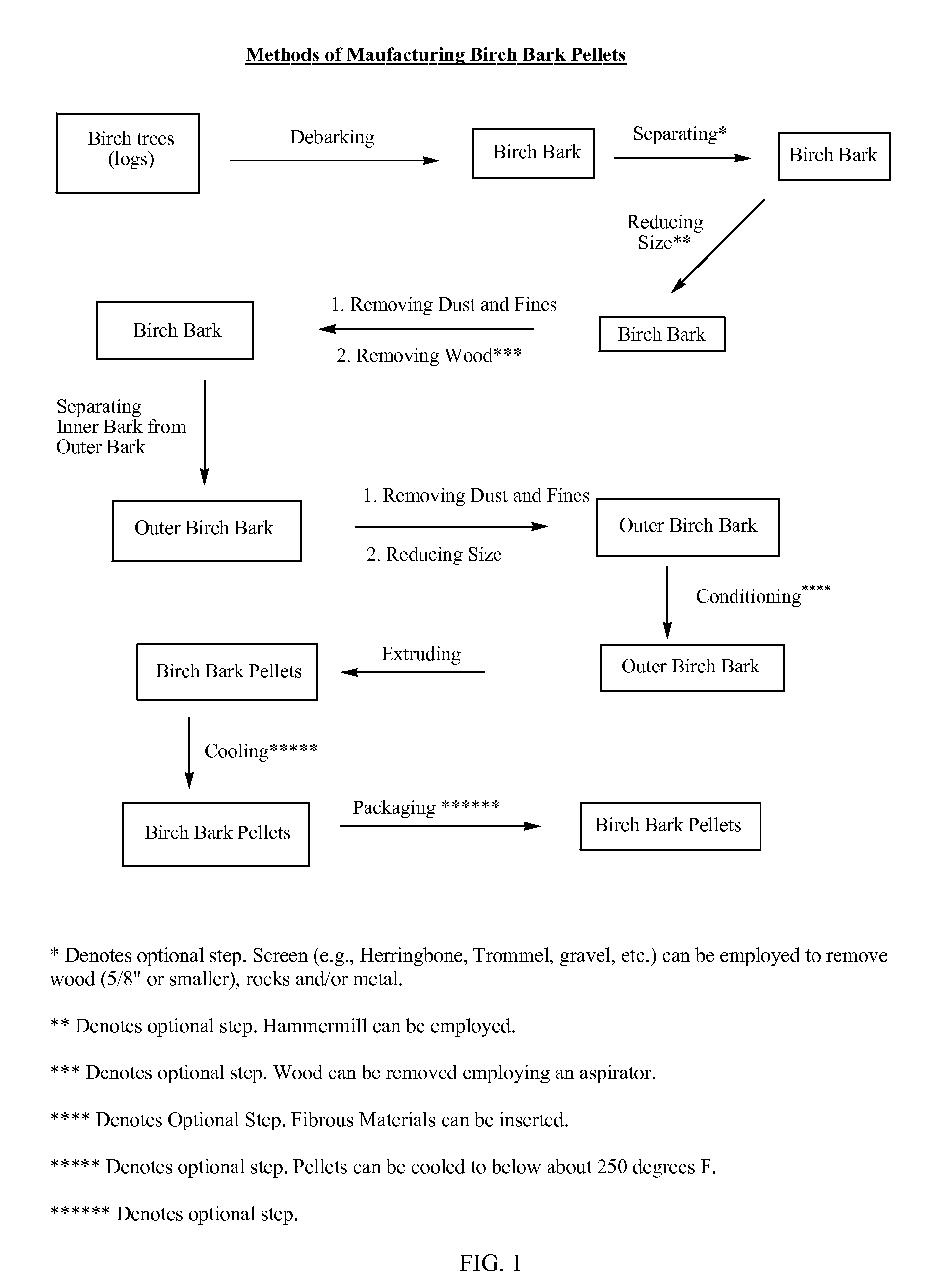Birch bark pelletization and methods for obtaining natural products from birch bark pellets
a technology of birch bark and pelletization, which is applied in the field of birch bark pelletization and methods for obtaining natural products from birch bark pellets, can solve the problems of reducing the overall yield of betulin, and reducing the efficiency of betulin isolation, so as to reduce shipping and processing costs, increase the yield of natural products, and reduce the effect of processing costs
- Summary
- Abstract
- Description
- Claims
- Application Information
AI Technical Summary
Benefits of technology
Problems solved by technology
Method used
Image
Examples
example 1
Birch Bark Processing
[0195]A bark batch feeder (6,000 pound per hour or 1,200 cubic feet per hour) was loaded with a bucket loader from a bark pile. The feeder provided an even flow of bark to a belt conveyor going to the hammermill. The bark lay down area included a fines blower and fines van parked on the site and a bag house, which was required to control dust.
[0196]A hammermill (6,000 pound per hour or 1,200 cubic feet per hour) was fed by a belt conveyor. It was discharged by a fan operated by same drive motor as the hammermill. The fan moved shredded bark and fines to a cyclone with rotary airlock. The rotary airlock discharged to a screw auger conveyor to take inner and outer bark to 2 deck screens (mesh), which will handle 6,000 pounds per hour. A fines auger took inner bark “rejects” (4,800 pounds per hour) from the screen to a blower. A blower discharged inner bark fines into a van trailer.
[0197]Screened outer bark “accepts” (1,200 pounds per hour) were discharged onto a s...
example 2
[0200]The density of representative birch bark pellets described herein can be found in Table 1 below.
TABLE 1LengthDiameterVolumeWeightDensityStd(cm)(cm)(cc)(g)(g / cc)MeandevRSDPellets after wood removal system installed1.500.6350.4750.49881.0511.700.6350.5380.60321.1212.000.6350.6330.68081.0751.300.6350.4110.43501.0571.450.6350.4590.51131.1141.750.6350.5540.56861.0262.050.6350.6490.67761.0441.600.6350.5060.53121.0492.000.6350.6330.63701.0062.200.6350.6960.74081.0641.0610.0363.35%Pellets before wood removal system installed1.700.6350.5380.66501.2361.950.6350.6170.75981.2311.550.6350.4910.57901.1801.800.6350.5700.68421.2012.100.6350.6650.80611.2131.500.6350.4750.57351.2081.900.6350.6010.74201.2341.300.6350.4110.48861.1871.950.6350.6170.74341.2040.900.6350.2850.35651.2511.2150.0231.88%
example 3
Isolation of Betulin from Birch Bark Pellets
[0201]
TABLE 2Materials:Quantity:Birch Bark Pelletscontaining typically15-25% w / w BetulinToluene7 kg / kg Pellets10% Aqueous NaOH Solution1 kg / 5 kg of TolueneEquipmentTypeLittleford Day ExtractorReactor / Settler with Recirculation LoopNeutsche Type Filter
[0202]This process was performed in all stainless steel equipment. All process lines carrying extract were jacketed and maintained at a minimum temperature of 95° C.
[0203]The process described employed a 1,000 gallon Littleford Day Extractor, equipped with a horizontal plough type agitator, suitable solids feed hopper system, and a dry solids discharge system.
[0204]Approximately 700 kg of birch bark pellets were charged to the extractor, via the integral hopper system, and the system was blanketed with nitrogen. The system was heated to between 85 and 105° C., preferably 95° C. 4,900 kg of toluene preheated to 95° C. was fed to the extractor, under nitrogen pressure and the system was left pre...
PUM
| Property | Measurement | Unit |
|---|---|---|
| Temperature | aaaaa | aaaaa |
| Temperature | aaaaa | aaaaa |
| Temperature | aaaaa | aaaaa |
Abstract
Description
Claims
Application Information
 Login to View More
Login to View More - R&D
- Intellectual Property
- Life Sciences
- Materials
- Tech Scout
- Unparalleled Data Quality
- Higher Quality Content
- 60% Fewer Hallucinations
Browse by: Latest US Patents, China's latest patents, Technical Efficacy Thesaurus, Application Domain, Technology Topic, Popular Technical Reports.
© 2025 PatSnap. All rights reserved.Legal|Privacy policy|Modern Slavery Act Transparency Statement|Sitemap|About US| Contact US: help@patsnap.com



